This is the third part in my series on drying and restarting a sourdough starter. The first part was learning how to dry a sourdough starter. The second part focused on reactivating a dried starter. This post focuses on baking classic sourdough bread in a cloche using the reactivated starter.
I decided to test my reactivated starter by making a classic sourdough bread. I had a specific purpose in mind for this bread, and it needed to be round, so I opted to make it in my La Cloche.
I used the method and formula outlined in Classic Sourdoughs by Ed and Jean Wood. Their process is a little bit different from the other sourdough breads I’ve made, and I was interested in finding out how the bread would perform (and taste). The whole sourdough phenomenon never ceases to amaze me so I’m always curious about different methods and techniques.
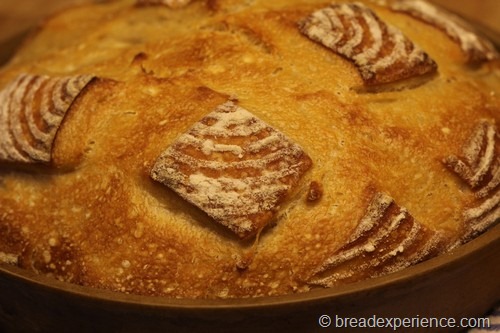
La Cloche Sourdough
Makes: One 2 1/8-pound (1010g) French loaf
Method adapted from: Classic Sourdoughs by Ed and Jean Wood.
Ingredients:
Active Culture
- Warm water
- 90g (2/3 cup) all-purpose flour
Culture Proof
- 180g (1 1/3 cup) of all-purpose flour, divided
- Warm water
Final Dough:
- 1 cup (240 ml) culture from the culture proof (see below)
- 1 1/2 cups (360 ml) water (I used Spring water)
- 2 teaspoons salt
- 4 1/4 cups (595 g) unbleached all-purpose flour
Method:
In the book, The Woods contend that warming and feeding a refrigerated sourdough for a couple of hours is not enough to prepare it for use in bread so they utilize a “culture proof.” This sounded reasonable to me, but it is an extra step so I’ll need to do some further testing. For now, I like the result.
1) Fully Active Culture
To begin the process, you need to make sure you have a fully active culture. If your culture has been sitting in the refrigerator for longer than a week, the book contends that you need to reduce the acidity level. My reactivated starter is fairly new and had been fed recently (in the past week), however, the acidity level seemed to be fairly strong. So I followed their process for reducing the acidity level before feeding and continuing the process.
To reduce the acidity level, when you take the culture out of the refrigerator, fill the jar with warm water while stirring vigorously. Leave slightly more than 1 cup (240 ml) in the jar and discard the excess.
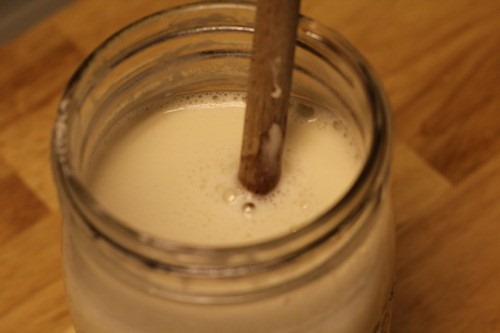
Feed the culture in the jar with 90g (2/3 cup) all-purpose flour and enough water to restore the consistency of thick pancake batter. The jar should now be slightly more than half full. My jar wasn’t quite half full, but it worked anyway. I placed some tape on it so I could see when the volume increased by 2 inches.
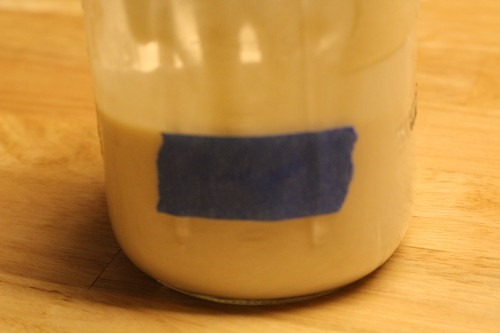
Proof at 70 to 75 degrees F (21 to 24 degrees C). The temperature in my house was about 65 degrees F so I put my culture in the oven with the light turned on for a little while (maybe 15 minutes), then turned the oven light off for the remaining 3 1/2 hours or so.
If the culture has been in the refrigerator for less than 2 weeks, it should become fully active in about 2 to 4 hours when proofed at room temperature. As soon as it forms foam and bubbles that increase the volume by about 2 inches (5 cm) in a quart (liter) jar within 2 to 4 hours of the last feeding, it is fully active and ready for use in the culture proof. If the culture has been refrigerated for more than 2 weeks, you may need to repeat this procedure. As you can see in the photo below, the culture was foamy and the volume had increased by 2 inches. It was ready for the culture proof.
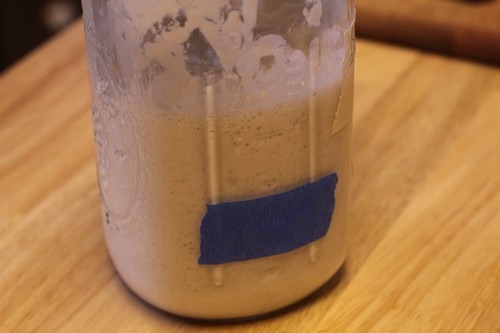
2) Culture Proof
Start with the fully active culture. Stir it vigorously and put half in another jar. To each jar, add 90g (2/3 cup) of all-purpose flour and enough water to maintain the thick pancake-batter consistency (approximately 1/2 cup/120 ml). Proof for 8 to 12 hours.
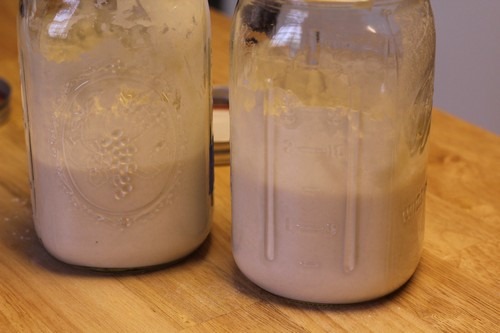
I started the culture proof at 12pm. I placed the jars in the oven with the light off for 3 hours, then I turned the light on let them proof for another 6 hours with the light on. According to the book, this process results in a good concentration of both yeast and bacteria, producing good flavor, leavening, and sourness.*
This is what the culture looked like after 9 hours. It’s ready to be used in bread.
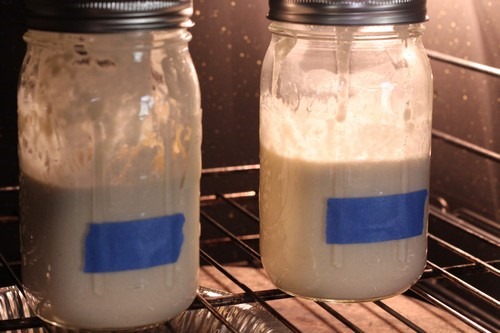
* When you make the loaves, if the dough seems quite active, but the loaves do not rise or they retract when baked, it is probably due to the acidity level in the dough. If the loaf is unusually sour, you’ll know this is what happened. Of course, some people prefer really sour sourdoughs. I don’t happen to be one of them.
3) Dough Proof:
Pour the amount of culture needed into a mixing bowl. The remaining jar can be fed and placed in the refrigerator to use another day. Add the water and salt to the culture and mix well.
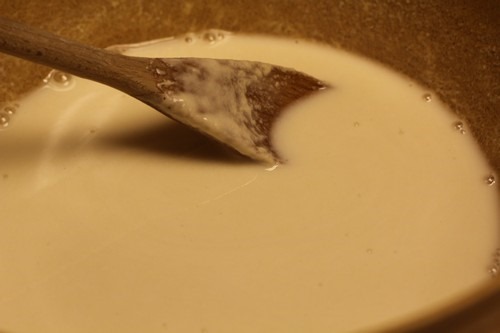
Add the flour a cup (140g) at a time until the dough is too stiff to mix by hand. I used my Danish Dough Whisk until the dough was too thick to stir, then I used my hands in the bowl to finish mixing it.
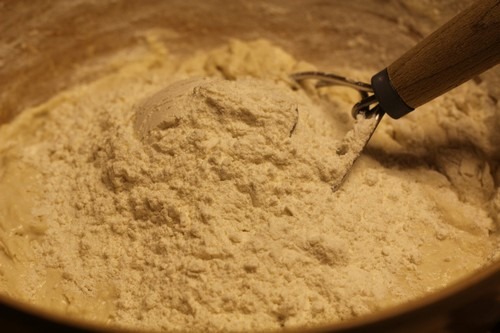
Turn the dough out onto a floured surface and knead in the remaining flour until the dough is smooth and satiny.
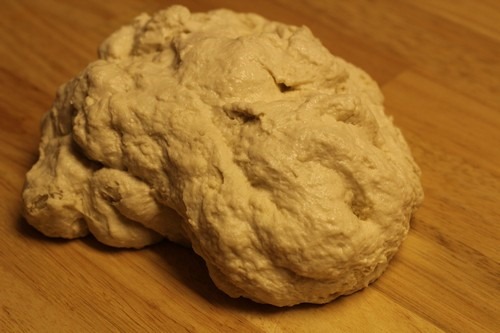
Proof the dough overnight (8 to 12 hours) at room temperature, about 70 degrees F (21 degrees C), in a large bowl covered with plastic wrap.
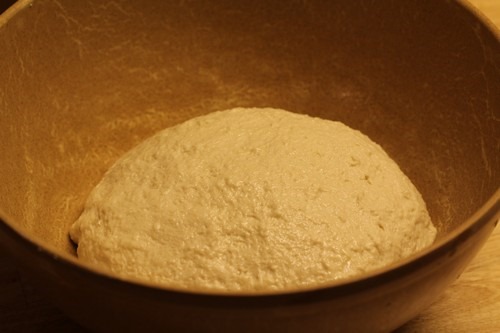
During this time, the dough should double in size. My dough proofed from 9:15pm to about 11am the next day. The temperature was lower in my kitchen so I let it proof longer.
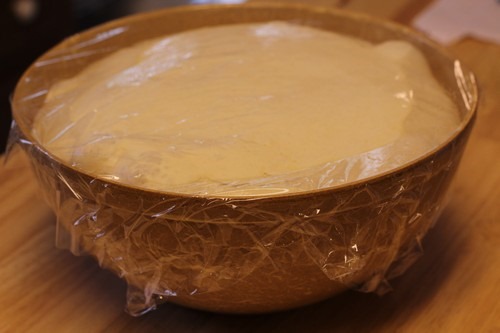
4) Loaf Proof:
Use a spatula to gently ease the dough out onto a floured surface. Allow the dough to rest for 30 minutes. If the dough flattens a lot during this time, knead in additional flour before shaping it into the desired shape.

This is where I deviated from the directions. I let the dough rest for a few minutes, then I shaped it into a rough ball, covered it with plastic and let it rest for about 20 minutes.
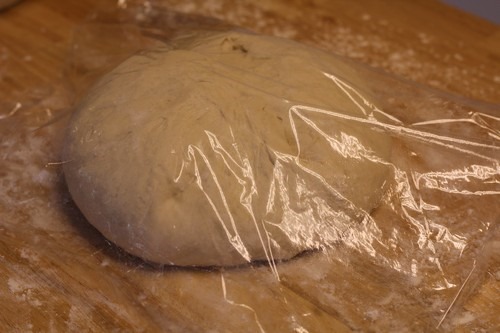
Then I placed the dough ball, seam-side up into a floured proofing basket and covered it with plastic wrap.
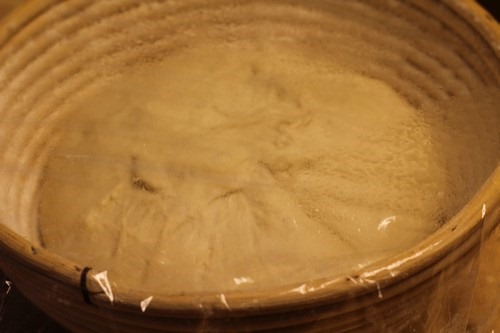
I let the dough proof for 4 hours until it had doubled in size. I placed it in the oven with the light turned off for this phase.
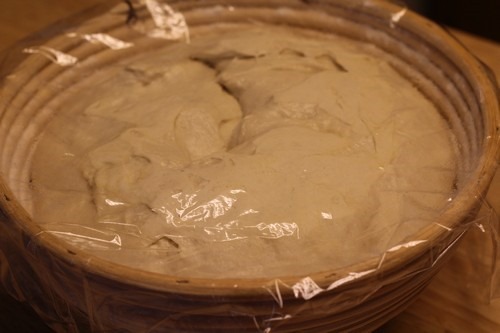
5) Baking the Loaf:
Preheat the oven to 500 degrees F (260 degrees C). There is no need to place a baking stone or steam pan underneath because the La Cloche acts as the brick oven.
Gently transfer the loaf to the La Cloche. Fortunately, my loaf slipped easily out of the proofing basket. It didn’t stick at all. I use a combination of rice and all-purpose flour sprinkled in the basket and this seems to help keep it from sticking.
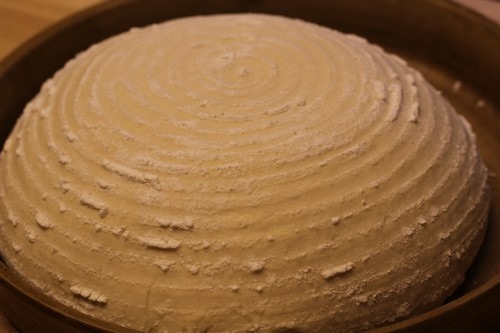
Slash the loaf with the desired pattern of choice. I slashed my loaf in a criss-cross pattern. There’s a reason I chose this pattern, but you’ll have to wait until my next post to find out.
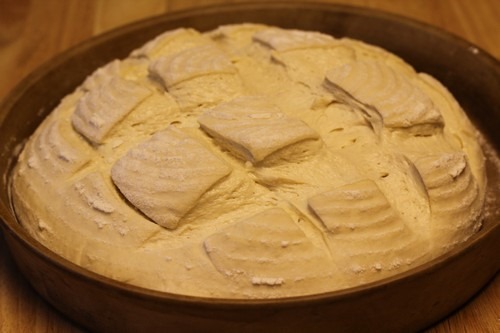
Place the lid on the La Cloche and bake the loaf for 30 minutes at 500 degrees F (260 degrees C).
Remove the lid and reduce the oven temperature to 400 degrees F (200 degrees C).
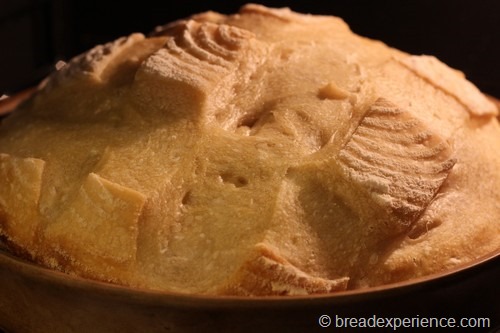
Continue baking the loaf for about 15 minutes, or until the crust is brown.
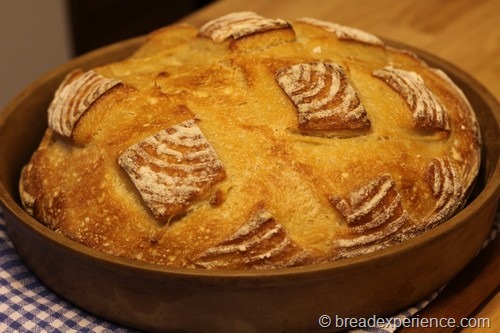
6) Cooling and Slicing the Loaf
Remove the loaf from the dish and let it cool on a wire rack for at least 15 to 20 minutes before slicing.
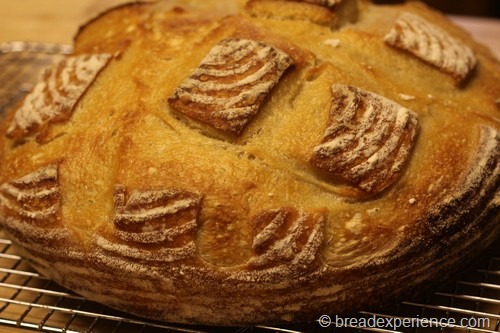
This bread had a beautiful and crispy crust. I didn’t take a shot of the crumb because I didn’t want to slice it yet. Like I mentioned earlier, I had a special purpose for this bread. I let it cool for about an hour or so, then I proceeded with the next phase in the life of this bread.
The next phase in the life of this bread was turning it into Bloomin’ Onion Bread. It’s a fun bread that you ought to try.
Happy Baking!
Cathy

Heather @girlichef.com says
This is fabulous! I love sourdough and am SO fascinated by all of the different processes, as well. I’ve loved all of the posts you’ve done on the various forms. Gorgeous!
Cathy (breadexperience) says
Thanks Heather! I’ve been having fun with this.
Anonymous says
Hi Cathy,
Looks great. Do you preheat La Cloche in the oven, or just place the dough in it unheated?
Thanks
Cathy (breadexperience) says
Thanks! I didn’t preheat the La Cloche. I let the dough rise in it, then I placed it in the preheated oven with the lid on.
Anonymous says
Thank you, just what I wanted to know. I was worried about damaging the La Cloche.
Saves a step too, as the proof is done right in the La Cloche. I will try this.
Joyfulbaker says
Cathy, I have heard that placing the cold La Cloche into a preheated (475-500 dF) oven may cause either the bell or the base to crack (thermal shock), Is that a cause for concern?
Cathy W. says
Joyfulbaker, I’ve been using my Sassafras La Cloche for several years. I don’t preheat it and I’ve never had any problems. When I remove it from the oven, I do make sure that I place the bell and the bottom on a wooden board covered with cloth so that the change in temperature doesn’t crack it when it comes out of the oven. You can certainly preheat it if you’re concerned about cracking it, just be very careful when you transfer the bread from the basket to the cloche.
Anonymous says
Do you grease the La Cloche?
Cathy W. says
Hello, you don’t need to grease the cloche, but you might want to sprinkle the bottom with cornmeal before placing the loaf in it.
Fatima says
Hello,
I love this bread. There is one problem that I am having while proofing the dough before placing it in the cloche. Even after heavily flouring the proofing basket , the dough sticks to it really bad and does not slide off easily into the cloche. I also tried using the parchment paper to line the proofing basket , but the dough still sticks to the parchment paper too. I even tried oiling the parchment paper.
What do you think is going on with my dough. I follow directions very carefully. I also use a digital scale for ingredients and it is not too hot or cold in my kitchen. I would greatly appreciate some help here. Thanks
Cathy says
Hi Fatima,
I hate it when that happens. I had the same issue with a high-hydration bread I made this past weekend. I ended up using a heavily-floured liner in the proofing basket and it worked great. If you don’t have a liner, just line a proofing basket with a kitchen towel and sprinkle it heavily with flour. Try using rice flour or a mixture of AP/rice flour or corn flour to dust the basket. The dough seems to stick less with those flours.
Or, if you prefer to use parchment paper, just don’t remove the loaf from the parchment paper prior to baking. Place the loaf (and the parchment paper “sling”) into the cloche. Then bake it. If you do it this way, you’ll want to proof the loaf seamside down.
Let me know how it goes.
Happy Baking!
Cathy
June Case says
I have been reading up on use of the LaCloche baker and some sites say preheat…some say no. The one method which makes a lot of sense to me, is to proof the bread in the base, but preheat the bell to the desired temperature, starting it in a cold oven. In this way, you don’t have to move the dough around or over handle it…but you don’t risk as much when you put the base in the preheated oven. Does anyone have any thoughts on this? I getting ready to do my initial use of this baker and would like to start off on the right foot!
Cathy says
Hi June,
I’ve used a cold la cloche in a preheated oven and I’ve also allowed the cloche to preheat while the oven was preheating. It works either way. However, I find that with most bakers, if you let the baker preheat in the oven at least 45 minutes, you get better oven spring. These days, I typically let the dough proof seamside up in a proofing basket. Then I preheat the cloche (bell and base) while the oven is preheating, and then I carefully flip the proofed loaf into the base. Then I score the loaf and carefully place the base in the oven and cover it with the bell and proceed with baking. You just need to make sure that you place the cloche bell and base on a towel or pot holder or something to keep it from cracking due to the change in temperature when you remove it to put the loaf in it and again when you remove it once it’s baked.
Happy Baking!
Cathy